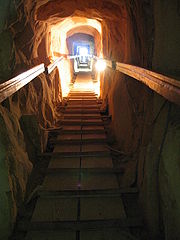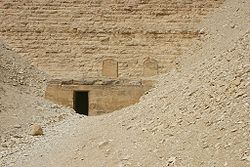
Meidum
Encyclopedia
Located about 100 km south of modern Cairo
, Meidum or Maidum is the location of a large pyramid
, and several large mud-brick mastaba
s.
 The pyramid at Meidum is thought to have been originally built for Huni
The pyramid at Meidum is thought to have been originally built for Huni
, the last pharaoh of the Third Dynasty
. It was completed and probably usurped by his successor, Sneferu
, who also turned it from a step pyramid
to a true pyramid by filling in the steps with limestone encasing. The Meidum pyramid was built in different stages, beginning as a seven-step pyramid to which an additional step was added at a later stage. It appears to have collapsed sometime during the New Kingdom
. A subsidiary pyramid is located on the south side, between the main pyramid and the enclosure wall, and a memorial temple is on its east side.
Known as "the collapsed pyramid", the outer layers of the casing began to collapse, leaving the core exposed. Because of its appearance, it is called el-haram el-kaddab — (Fake Pyramid) in Egyptian Arabic. Some believe it was the collapse of this pyramid during the reign of Sneferu that led him to changeto 43 degrees the angle of his second pyramid at Dahshur
.. In the fifteenth century, it was described as looking like a five-stepped mountain by al-Maqrizi
, gradually falling further into ruin so by the time it was investigated by Napoleon's Expedition in 1799 it had its present 3 steps.
It was excavated by John Shae Perring
in 1837, Lepsius
in 1843 and then by Flinders Petrie later in the nineteenth century, who located the mortuary temple, facing to the east. In 1920 Ludwig Borchardt
studied the area further, followed by Alan Rowe in 1928 and then Ali el-Kholi in the 1970s.
 In its ruined state, the structure is 65 m high, and its entrance is aligned north-south, with the entrance in the north, 20 metres above present ground level. The steep descending passage 57 metres long leads to a horizontal passage, just below the original ground level, that then leads to a vertical shaft 10 metres high that leads to the corbelled burial chamber itself. It is thought to be unlikely that Sneferu was buried here — whether Huni
In its ruined state, the structure is 65 m high, and its entrance is aligned north-south, with the entrance in the north, 20 metres above present ground level. The steep descending passage 57 metres long leads to a horizontal passage, just below the original ground level, that then leads to a vertical shaft 10 metres high that leads to the corbelled burial chamber itself. It is thought to be unlikely that Sneferu was buried here — whether Huni
was may never be known, though construction may have begun during his reign.
Flinders Petrie was the first Egyptologist to establish the facts of its original design dimensions and proportions. In its final form it was 1100 Cubits of 0.523 m around by 175 Cubits high, thus showing the same proportions as the Great Pyramid at Giza, and therefore the same circular symbolism. Petrie wrote in the 1892 excavation report that "We see then that there is an exactly analogous theory for the dimensions of Medum[sic] to that of the Great Pyramid ; in each the approximate ratio of 7 : 44 is adopted, as referred to the radius and circle..". These proportions equated to the four outer faces sloping in by precisely 51.842° or 51° 50' 35", which would have been understood and expressed by the Ancient Egyptians as a seked
slope of 5½ palms
of an unknown noble, the burial chamber of which can be entered via a robber's tunnel. This tunnel is steep, extremely narrow and confined. Once traversed however, the chamber and hallway are relatively spacious, and contain the first example of a red granite sarcophagus known in antiquity. Another mastaba is the Mastaba of Nefermaat.
The stone sarcophagus
remains within the unmarked and undecorated granite built chamber. The tunnel goes further on into the darkness, and as of 2002 remains unexplored.
Cairo
Cairo , is the capital of Egypt and the largest city in the Arab world and Africa, and the 16th largest metropolitan area in the world. Nicknamed "The City of a Thousand Minarets" for its preponderance of Islamic architecture, Cairo has long been a centre of the region's political and cultural life...
, Meidum or Maidum is the location of a large pyramid
Pyramid
A pyramid is a structure whose outer surfaces are triangular and converge at a single point. The base of a pyramid can be trilateral, quadrilateral, or any polygon shape, meaning that a pyramid has at least three triangular surfaces...
, and several large mud-brick mastaba
Mastaba
A mastaba, or "pr-djt" , is a type of ancient Egyptian tomb in the form of a flat-roofed, rectangular structure with outward sloping sides that marked the burial site of many eminent Egyptians of Egypt's ancient period...
s.
Pyramid

Huni
Huni was the last Pharaoh of Egypt of the Third dynasty. He was the successor to Khaba.-Family:Huni was the father of Hetepheres I, the wife of Sneferu who was the first king of the Fourth Dynasty...
, the last pharaoh of the Third Dynasty
Third dynasty of Egypt
For the Sumerian Renaissance, see Third Dynasty of Ur.The Third Dynasty of ancient Egypt is the first dynasty of the Old Kingdom. Other dynasties of the Old Kingdom include the Fourth, Fifth and Sixth...
. It was completed and probably usurped by his successor, Sneferu
Sneferu
Sneferu, also spelled as Snephru, Snefru or Snofru , was the founder of the Fourth dynasty of Egypt. Estimates of his reign vary, with for instance The Oxford History of Ancient Egypt suggesting a reign from around 2613 BC to 2589 BC, a reign of 24 years, while Rolf Krauss suggests a 30-year reign...
, who also turned it from a step pyramid
Step pyramid
Step pyramids are structures which characterized several cultures throughout history, in several locations throughout the world. These pyramids typically are large and made of several layers of stone...
to a true pyramid by filling in the steps with limestone encasing. The Meidum pyramid was built in different stages, beginning as a seven-step pyramid to which an additional step was added at a later stage. It appears to have collapsed sometime during the New Kingdom
New Kingdom
The New Kingdom of Egypt, also referred to as the Egyptian Empire is the period in ancient Egyptian history between the 16th century BC and the 11th century BC, covering the Eighteenth, Nineteenth, and Twentieth Dynasties of Egypt....
. A subsidiary pyramid is located on the south side, between the main pyramid and the enclosure wall, and a memorial temple is on its east side.
Known as "the collapsed pyramid", the outer layers of the casing began to collapse, leaving the core exposed. Because of its appearance, it is called el-haram el-kaddab — (Fake Pyramid) in Egyptian Arabic. Some believe it was the collapse of this pyramid during the reign of Sneferu that led him to changeto 43 degrees the angle of his second pyramid at Dahshur
Dahshur
Dahshur , is a royal necropolis located in the desert on the west bank of the Nile approximately 40 kilometres south of Cairo...
.. In the fifteenth century, it was described as looking like a five-stepped mountain by al-Maqrizi
Al-Maqrizi
Taqi al-Din Ahmad ibn 'Ali ibn 'Abd al-Qadir ibn Muhammad al-Maqrizi ; Arabic: , was an Egyptian historian more commonly known as al-Maqrizi or Makrizi...
, gradually falling further into ruin so by the time it was investigated by Napoleon's Expedition in 1799 it had its present 3 steps.
It was excavated by John Shae Perring
John Shae Perring
John Shae Perring was a British engineer, anthropologist and Egyptologist, most notable for his work excavating and documenting Egyptian pyramids...
in 1837, Lepsius
Karl Richard Lepsius
Karl Richard Lepsius was a pioneering Prussian Egyptologist and linguist and pioneer of modern archaeology.-Background:...
in 1843 and then by Flinders Petrie later in the nineteenth century, who located the mortuary temple, facing to the east. In 1920 Ludwig Borchardt
Ludwig Borchardt
Ludwig Borchardt was a German Egyptologist who was born in Berlin.-Life:Borchardt initially studied Architecture and later Egyptology under Adolf Erman. In 1895 he journeyed to Cairo and produced, with Gaston Maspero, the Catalogue of the Egyptian Museum...
studied the area further, followed by Alan Rowe in 1928 and then Ali el-Kholi in the 1970s.

Huni
Huni was the last Pharaoh of Egypt of the Third dynasty. He was the successor to Khaba.-Family:Huni was the father of Hetepheres I, the wife of Sneferu who was the first king of the Fourth Dynasty...
was may never be known, though construction may have begun during his reign.
Flinders Petrie was the first Egyptologist to establish the facts of its original design dimensions and proportions. In its final form it was 1100 Cubits of 0.523 m around by 175 Cubits high, thus showing the same proportions as the Great Pyramid at Giza, and therefore the same circular symbolism. Petrie wrote in the 1892 excavation report that "We see then that there is an exactly analogous theory for the dimensions of Medum[sic] to that of the Great Pyramid ; in each the approximate ratio of 7 : 44 is adopted, as referred to the radius and circle..". These proportions equated to the four outer faces sloping in by precisely 51.842° or 51° 50' 35", which would have been understood and expressed by the Ancient Egyptians as a seked
Seked
The seked was an ancient Egyptian unit for the measurement of the slope of an inclined surface. The system was based on the Egyptian's linear measure known as the royal cubit. The royal cubit was subdivided into seven palms and each palm was further divided into four digits...
slope of 5½ palms
Mastabas
Located nearby is a mastabaMastaba
A mastaba, or "pr-djt" , is a type of ancient Egyptian tomb in the form of a flat-roofed, rectangular structure with outward sloping sides that marked the burial site of many eminent Egyptians of Egypt's ancient period...
of an unknown noble, the burial chamber of which can be entered via a robber's tunnel. This tunnel is steep, extremely narrow and confined. Once traversed however, the chamber and hallway are relatively spacious, and contain the first example of a red granite sarcophagus known in antiquity. Another mastaba is the Mastaba of Nefermaat.
The stone sarcophagus
Sarcophagus
A sarcophagus is a funeral receptacle for a corpse, most commonly carved or cut from stone. The word "sarcophagus" comes from the Greek σαρξ sarx meaning "flesh", and φαγειν phagein meaning "to eat", hence sarkophagus means "flesh-eating"; from the phrase lithos sarkophagos...
remains within the unmarked and undecorated granite built chamber. The tunnel goes further on into the darkness, and as of 2002 remains unexplored.
Further reading
- Arnold, Dieter 1991. "Building in Egypt: Pharaonic Stone Masonry" Oxford. Oxford University Press
- Jackson, K & J. Stamp. "Pyramid : Beyond Imagination. Inside the Great Pyramid of Giza"BBC Worldwide Ltd, 2002, ISBN 978-0563488033

